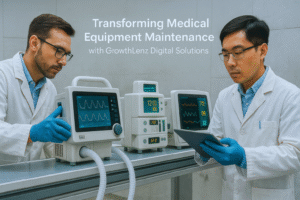Manufacturers today face a confluence of challenges: unpredictable demand, shifting supply chains, evolving trade dynamics, and an urgent need for workforce modernization. At the same time, digital technologies have become increasingly accessible and essential. Those who effectively harness digitalization to improve Productivity, streamline Processes, and drive Profitability are gaining a competitive edge. This article explores how manufacturers can avoid common digital missteps, overcome fragmented implementations, and realize full value through a structured, strategic approach built around the 3 Ps and the IOC framework.
1. Manufacturing’s Digital Inflection Point
The last few years have dramatically reshaped the manufacturing landscape. Many organizations accelerated digital adoption out of necessity, implementing remote collaboration tools, smart systems, and data-driven operations. What began as reactive has now become foundational. Manufacturers that are progressing in their digital journey are reporting measurable gains in throughput, quality, and responsiveness.
Smart manufacturing practices—ranging from predictive maintenance to real-time analytics—are enabling higher output with fewer resources. The result is a more agile and resilient production model. Digital transformation is no longer optional; it is central to long-term operational success.
2. The Cost of Fragmented Digital Investments – The “Digital Drain”
Despite growing adoption, many organizations struggle to fully capitalize on their digital investments. A common pitfall is the isolated acquisition of software tools by individual functions, leading to overlapping capabilities, inconsistent adoption, and excessive spending on unused licenses.
Without centralized visibility and governance, organizations accumulate a portfolio of underutilized applications. This “digital drain” not only wastes resources but also adds complexity, undermines integration, and delays strategic outcomes.
Proactive management of digital assets is essential. Organizations must move from scattered purchases to a unified strategy that supports enterprise-wide priorities.
3. Defining the 3 Ps
|
P |
Definition |
Why It Matters |
|
Profitability |
Sustainable growth in gross margin, operating income and cash flow. |
Validates ROI of digital initiatives; funds future innovation. |
|
Productivity |
Output generated per unit of labor, machine time or capital deployed. |
Drives cost competitiveness and capacity to meet demand surges. |
|
Processes |
Standardized, waste-free workflows that convert inputs to outputs. |
Minimizes errors, variability and lead time, lifting both productivity and quality. |
Interdependency: Optimized processes remove friction, elevating productivity, which in turn feeds directly into profitability. A weakness in any one P drags the others down.
4. From Vision to Value: The IOC Framework
To bridge the gap between digital potential and business outcomes, manufacturers should adopt a focused, three-step approach:
-
Inventory – Build a comprehensive catalogue of all digital tools and automation assets, capturing usage data, renewal terms, and user feedback. This visibility lays the foundation for informed decisions.
-
Optimize (Governance) – Establish a cross-functional review board led by IT and business leaders. Assess tool performance, identify overlaps, streamline licenses, and align technology spend with strategic goals.
-
Connect – Implement an integration layer that unifies data across systems and applications, enabling real-time insights without replacing existing infrastructure.
Outcome: This approach ensures that every digital initiative directly contributes to improving at least one of the 3 Ps.
5. Implementing IOC: Seven Practical Steps
-
30‑Day Baseline Sprint – Consolidate all software records and generate an initial inventory.
-
Heat‑Map Value vs. Adoption – Evaluate each application based on actual business impact and usage.
-
Quick‑Win Deactivations – Retire low-value, low-adoption tools.
-
Set Governance Charter – Define review cycles, ownership, and decommissioning criteria.
-
Select Lightweight Middleware – Choose flexible solutions that integrate OT and IT systems.
-
Launch 3 P KPI Dashboard – Track metrics like OEE, quality yield, energy usage, and cost per unit.
-
Iterate in 90‑Day Cycles – Review outcomes, adjust strategy, and refine the digital ecosystem.
6. Measuring What Matters
|
Objective |
Representative KPI |
Typical Improvement After IOC* |
|
Profitability |
EBITDA margin |
+3–5 pts |
|
Productivity |
Overall Equipment Effectiveness (OEE) |
+8–12 % |
|
Processes |
First‑pass yield / defect rate |
–15–25 % |
*Estimated ranges based on implementation outcomes across manufacturing environments.
7. Case Snapshot – Midwest Discrete Manufacturer (Hypothetical)
-
Challenge: 150‑app landscape, $4 M annual software spend, inconsistent KPIs across five plants.
-
Action: Applied IOC; retired 45 apps, renegotiated 12 vendor contracts, installed edge middleware.
-
Result (12 months):
-
Software spend –26 %
-
OEE +9.4 %
-
Scrap rate –18 %
-
EBITDA margin +4.2 pts
-
8. Building an Agile, Data‑Driven Culture
Technology alone is not enough. Successful transformation demands a culture that embraces transparency, continuous learning, and cross-functional collaboration. Key enablers include:
-
Leadership sponsorship – Consistent direction and visible support from senior executives.
-
Workforce upskilling – Training in digital tools, data analytics, and collaborative problem-solving.
-
Change‑management rigor – Clear communication, structured rollouts, and performance incentives.
Conclusion
Manufacturing excellence in the digital age requires more than isolated upgrades. It requires a cohesive strategy that links tools, people, and processes to clear business outcomes. By focusing on the 3 Ps—Profitability, Productivity, and Processes—and following the IOC framework, manufacturers can eliminate waste, amplify returns on digital investment, and position themselves for sustained growth and resilience.
Ready to unlock the true value of digital manufacturing? Our team helps you implement IOC and build a high-impact, data-driven manufacturing ecosystem.








